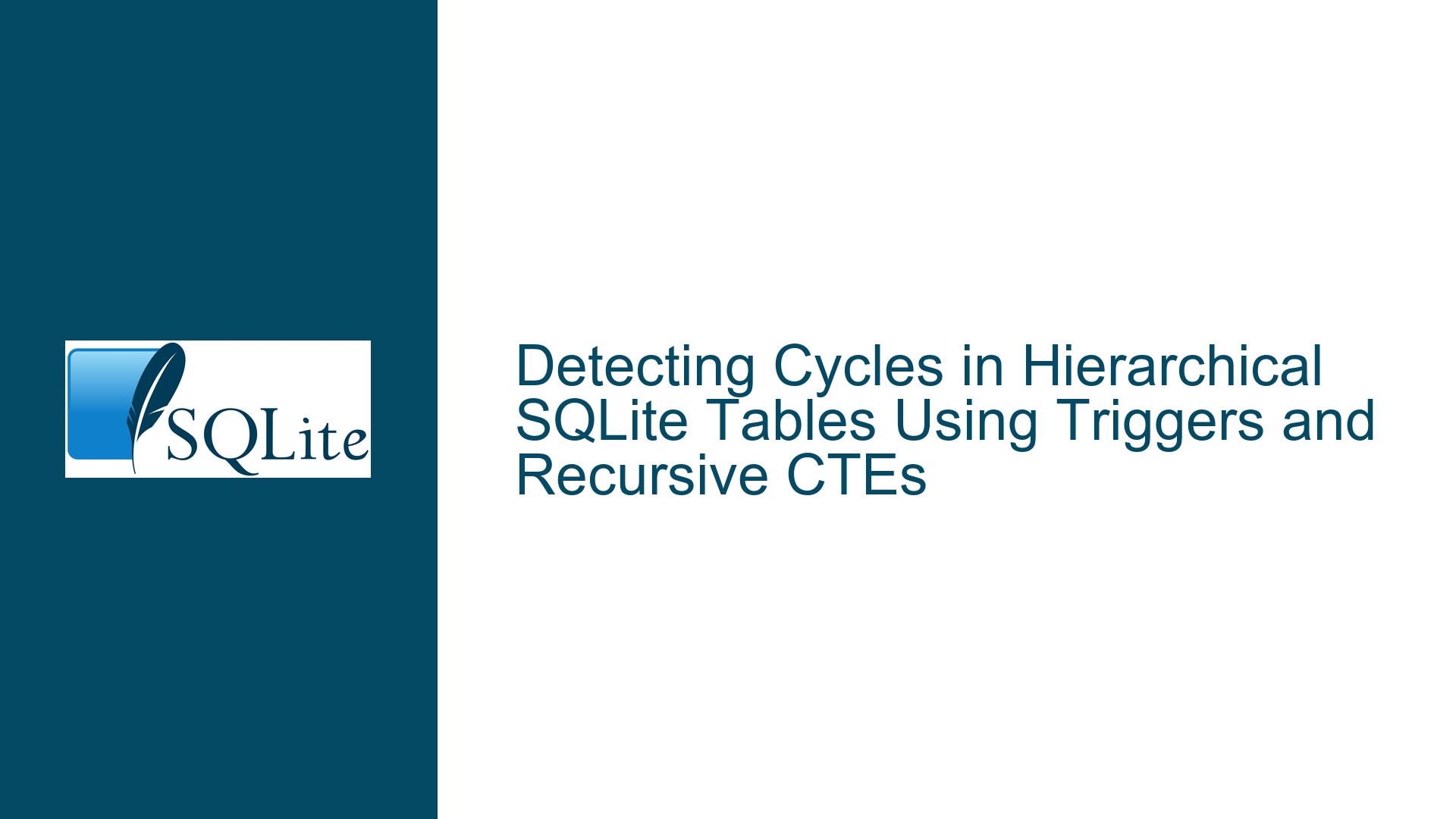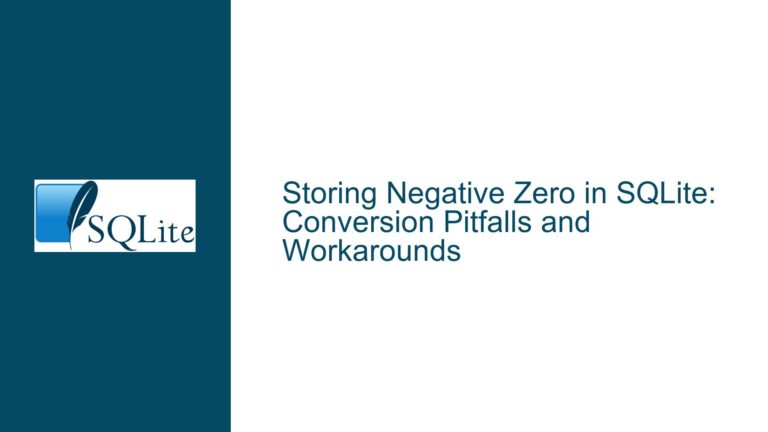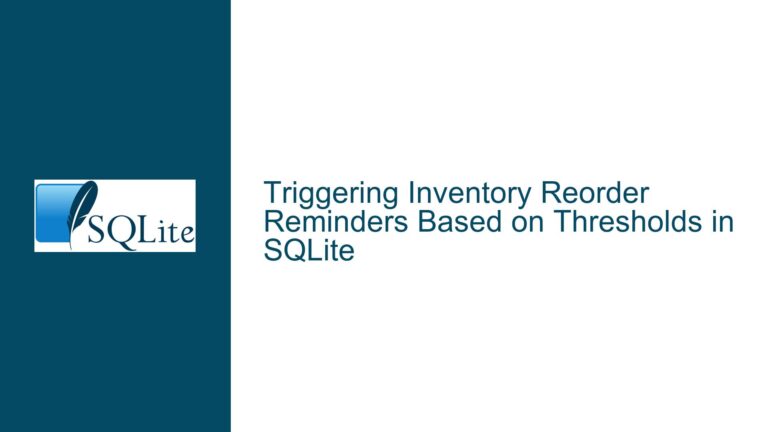Detecting Cycles in Hierarchical SQLite Tables Using Triggers and Recursive CTEs
Hierarchical Data Modeling and Cycle Detection in SQLite
When working with hierarchical data structures in SQLite, such as parent-child relationships, ensuring the integrity of the data is paramount. One common issue that arises in such structures is the introduction of cycles, which can lead to infinite loops and corrupt the logical integrity of the data. In this post, we will explore the challenges of detecting cycles in hierarchical tables, the limitations of using CHECK constraints, and how to effectively implement cycle detection using triggers and recursive Common Table Expressions (CTEs).
Hierarchical Data Modeling in SQLite
The schema provided in the discussion involves two tables: tag and tag_parents. The tag table stores unique tags, while the tag_parents table defines the hierarchical relationships between these tags. The tag_parents table has two foreign keys, from_tag_id and to_tag_id, which reference the id column in the tag table. This setup allows for a many-to-many relationship between tags, where a tag can have multiple parents and multiple children.
CREATE TABLE IF NOT EXISTS "tag" (
"id" integer NOT NULL PRIMARY KEY AUTOINCREMENT,
"name" varchar(40) NOT NULL UNIQUE
);
CREATE TABLE IF NOT EXISTS "tag_parents" (
"id" integer NOT NULL PRIMARY KEY AUTOINCREMENT,
"from_tag_id" integer NOT NULL REFERENCES "tag" ("id") DEFERRABLE INITIALLY DEFERRED,
"to_tag_id" integer NOT NULL REFERENCES "tag" ("id") DEFERRABLE INITIALLY DEFERRED
);
The challenge here is to prevent the introduction of cycles in the tag_parents table. A cycle occurs when a tag indirectly references itself through a chain of parent-child relationships. For example, if tag A is a parent of tag B, and tag B is a parent of tag A, a cycle is formed. Detecting such cycles is crucial for maintaining the integrity of the hierarchical structure.
Limitations of CHECK Constraints for Cycle Detection
Initially, the idea of using a CHECK constraint to prevent cycles was proposed. The CHECK constraint would use a recursive CTE to traverse the hierarchy and detect cycles. However, this approach fails because SQLite does not allow the use of subqueries or CTEs within CHECK constraints. The error Error: no such table: tag_parents occurs because the CHECK constraint attempts to reference the tag_parents table before it is fully created.
CONSTRAINT no_cycles CHECK (
NOT EXISTS (
WITH RECURSIVE p(root_id, end_id) AS (
SELECT DISTINCT to_tag_id AS root_id, to_tag_id AS end_id FROM tag_parents WHERE NOT EXISTS (SELECT 1 FROM tag_parents AS s WHERE s.from_tag_id=to_tag_id)
UNION ALL
SELECT t.from_tag_id, t.to_tag_id FROM tag_parents AS t
JOIN p ON t.to_tag_id = p.root_id)
SELECT 1 FROM p WHERE t=from_tag_id AND f=to_tag_id
)
)
This limitation highlights the need for an alternative approach to cycle detection. CHECK constraints are designed to evaluate conditions on a per-row basis and cannot perform complex queries or reference other rows in the table. Therefore, a different mechanism is required to enforce cycle-free hierarchies.
Implementing Cycle Detection with Triggers and Recursive CTEs
The solution to this problem lies in the use of triggers combined with recursive CTEs. A trigger can be defined to execute before an INSERT or UPDATE operation on the tag_parents table. Within the trigger, a recursive CTE can be used to traverse the hierarchy and detect cycles. If a cycle is detected, the trigger can raise an error, preventing the operation from completing.
Here is the trigger code that implements cycle detection:
CREATE TRIGGER cycle_check
BEFORE INSERT ON tag_parents
FOR EACH ROW
BEGIN
SELECT RAISE(ABORT, 'Cycle detected') WHERE EXISTS (
WITH RECURSIVE w(parent, last_visited, already_visited, cycle) AS (
SELECT DISTINCT to_tag_id AS parent, from_tag_id AS last_visited, to_tag_id AS already_visited, 0 AS cycle FROM tag_parents
UNION ALL
SELECT t.to_tag_id AS parent, t.from_tag_id AS last_visited, already_visited || ', ' || t.to_tag_id, already_visited LIKE '%'||t.to_tag_id||"%" FROM tag_parents AS t JOIN w ON w.last_visited = t.to_tag_id
WHERE NOT cycle
)
SELECT already_visited, cycle FROM w WHERE last_visited = NEW.to_tag_id AND already_visited LIKE '%'||NEW.from_tag_id||'%'
);
END;
This trigger works as follows:
Recursive CTE Initialization: The CTE
wis initialized with theto_tag_idas theparentandfrom_tag_idas thelast_visitednode. Thealready_visitedcolumn keeps track of the path traversed so far, and thecyclecolumn indicates whether a cycle has been detected.Recursive Traversal: The CTE recursively joins the
tag_parentstable with itself, following the parent-child relationships. Thealready_visitedcolumn is updated to include the current node, and thecyclecolumn is set to 1 if the current node has already been visited.Cycle Detection: The final SELECT statement checks if the
last_visitednode matches theNEW.to_tag_id(the new child being inserted) and if thealready_visitedpath contains theNEW.from_tag_id(the new parent being inserted). If both conditions are met, a cycle is detected, and the trigger raises an error.
This approach ensures that any attempt to insert a cycle into the tag_parents table will be aborted, maintaining the integrity of the hierarchical structure.
Optimizing the Schema for Hierarchical Data
While the trigger-based solution effectively prevents cycles, it is worth considering whether the schema itself can be optimized to simplify cycle detection and improve performance. One suggestion from the discussion is to use a single table with a self-referential parent column, rather than a separate tag_parents table. This approach simplifies the hierarchy to a tree structure, where each tag has at most one parent.
CREATE TABLE IF NOT EXISTS "tag" (
"id" integer NOT NULL PRIMARY KEY AUTOINCREMENT,
"name" varchar(40) NOT NULL UNIQUE,
"parent" integer REFERENCES "tag" ("id"),
UNIQUE(parent, name)
);
In this schema, the parent column references the id column of the same table, creating a self-referential relationship. This setup ensures that each tag has at most one parent, making it impossible to create cycles. However, this approach is limited to tree structures and does not support many-to-many relationships between tags.
For scenarios where multiple parents are required, the original schema with the tag_parents table is necessary. In such cases, additional optimizations can be applied to improve performance:
Indexing: Ensure that the
from_tag_idandto_tag_idcolumns are indexed to speed up the recursive traversal in the trigger. A composite index on(from_tag_id, to_tag_id)can also be beneficial.Unique Constraints: Add a
UNIQUE(from_tag_id, to_tag_id)constraint to prevent duplicate edges in thetag_parentstable.Foreign Key Constraints: Enable foreign key constraints using
PRAGMA foreign_keys = 1to enforce referential integrity between thetagandtag_parentstables.ON DELETE CASCADE: Use
ON DELETE CASCADEon the foreign keys to automatically delete edges when a tag is removed, ensuring that the hierarchy remains consistent.
Conclusion
Detecting cycles in hierarchical data structures is a critical aspect of maintaining data integrity in SQLite databases. While CHECK constraints are not suitable for this task due to their limitations, triggers combined with recursive CTEs provide a robust solution. By implementing a trigger that traverses the hierarchy and detects cycles before they are inserted, you can ensure that your hierarchical data remains cycle-free.
Additionally, optimizing the schema and indexing strategy can further enhance the performance and reliability of your database. Whether you choose to use a single table with a self-referential parent column or a separate table for many-to-many relationships, careful consideration of the schema design and constraints will help you build a robust and efficient hierarchical data model in SQLite.
By following the techniques and best practices outlined in this post, you can effectively manage hierarchical data in SQLite, ensuring that your database remains consistent, performant, and free from cycles.






